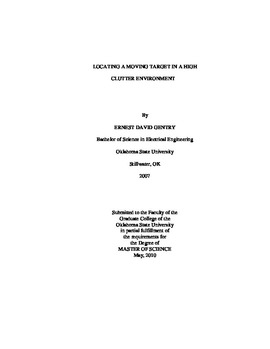| dc.contributor.advisor | West, James C. | |
| dc.contributor.author | Gentry, Ernest David | |
| dc.date.accessioned | 2014-04-17T20:08:32Z | |
| dc.date.available | 2014-04-17T20:08:32Z | |
| dc.date.issued | 2010-05-01 | |
| dc.identifier.uri | https://hdl.handle.net/11244/10203 | |
| dc.description.abstract | This paper addresses the problem of locating a slowly moving target in a high clutter environment. The test uses a vector network analyzer (VNA) as a radar system. The radar system is operated as a frequency-stepped continuous wave (FSCW) radar. The real and imaginary amplitude values of the S21 parameter are recorded for each frequency step. The inverse-fast Fourier (IFFT) is then applied to the complex S21 data to recover the time domain returns from a room or hallway. The target is located using a variable pulse repetition frequency (PRF) moving target indicator (MTI) filter. A reference pulse of the room or hallway was acquired, initially, with no target present. Consecutive pulses were then measured with the target present in the room or hallway. After each pulse, the target was moved 3 ft and a new measurement was saved. This process was repeated for each target. Targets included a corner reflector, a sphere, and a human subject. The results showed that the variable PRF, single-stage, MTI filter effectively identified the presence of a target in a high clutter environment for all three target cases. Subtracting a reference pulse from the pulses when a target was present in the room or hallway suppressed most of the background clutter. There were some returns from strong reflection points in the room or hallway still appeared in the filter returns, however. This was due to either the target intercepting and scattering the energy that would otherwise reflect from the background or the range cells of the background return signals being moved due to multipath. This test demonstrated that use of a reference pulse in a variable PRF MTI filter allowed the detection of a slowly moving target. Future work will be needed to address the issue of strong reflection points appearing after filtering. Possible solutions include addition of a second MTI stage to the processing. | |
| dc.format | application/pdf | |
| dc.language | en_US | |
| dc.publisher | Oklahoma State University | |
| dc.rights | Copyright is held by the author who has granted the Oklahoma State University Library the non-exclusive right to share this material in its institutional repository. Contact Digital Library Services at lib-dls@okstate.edu or 405-744-9161 for the permission policy on the use, reproduction or distribution of this material. | |
| dc.title | Locating a Moving Target in a High Clutter Environment | |
| dc.type | text | |
| dc.contributor.committeeMember | Bunting, Charles | |
| dc.contributor.committeeMember | Scheets, George | |
| dc.contributor.committeeMember | Chandler, Damon | |
| osu.filename | Gentry_okstate_0664M_11181.pdf | |
| osu.college | Engineering, Architecture, and Technology | |
| osu.accesstype | Open Access | |
| dc.description.department | School of Electrical & Computer Engineering | |
| dc.type.genre | Thesis | |
| dc.subject.keywords | high clutter | |
| dc.subject.keywords | moving target indicator | |
| dc.subject.keywords | pulse compression | |
| dc.subject.keywords | radar | |
| dc.subject.keywords | security system | |
